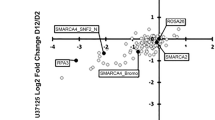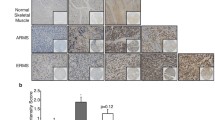Abstract
Alveolar (ARMS) and Embryonal (ERMS) rhabdomyosarcoma differ in their response to current treatments. The ARMS subtype has a less favourable prognosis and often presents with widespread metastases, while the less metastatic ERMS has a 5 year survival rate of more than 80 %. In this study we investigate gene expression differences that could contribute to the high frequency of metastasis in ARMS. Microarray analysis identified significant differences in DNA repair, cell cycle and cell migration between the two RMS subtypes. Two genes up regulated in ARMS and involved in cell migration; the engulfment and cell motility gene 1 (ELMO1) and NEL-like 1 gene (NELL1) were selected for further investigation. Over-expression of ELMO1 significantly increased cell invasion from 24.70 ± 7 % to 93 ± 5.4 % in primary myoblasts and from 29.43 ± 2.1 % to 87.33 ± 4.1 % in the ERMS cell line RD. siRNA knockout of ELMO1 in the ARMS cell line RH30 significantly reduced cell invasion from 88.2 ± 3.8 % to 35.2 ± 2.5 %. Over-expression of NELL1 significantly increased myoblast invasion from 23.6 ± 6.9 % to 100 ± 0.1 %, but had no effect on invasion of the ERMS cell line RD. These findings suggest that ELMO1 may play a key role in ARMS metastasis. NELL1 increased invasion in primary myoblasts, but other factors required for it to enhance motility were not present in the RD ERMS cell line. Impairing ELMO1 function by pharmacological or siRNA knockdown could be a highly effective approach to reduce the metastatic spread of RMS.







Similar content being viewed by others
References
Stevens M (2002) Malignant mesenchymal tumours of childhood. In: Souhami RL, Tannock I, Hohenberger P, Horiot JC (eds) Oxford textbook of oncology, 2nd edn. Oxford University Press, Oxford, pp 2525–2538
Barr FG et al (1993) Rearrangement of the PAX3 paired box gene in the paediatric solid tumour alveolar rhabdomyosarcoma. Nat Genet 3(2):113–117
Davis RJ et al (1994) Fusion of PAX7 to FKHR by the variant t(1;13)(p36;q14) translocation in alveolar rhabdomyosarcoma. Cancer Res 54(11):2869–2872
Bennicelli JL, Edwards RH, Barr FG (1996) Mechanism for transcriptional gain of function resulting from chromosomal translocation in alveolar rhabdomyosarcoma. Proc Nat Acad Sci USA 93(11):5455–5459
Epstein JA et al (1998) Tumor-specific PAX3-FKHR transcription factor, but not PAX3, activates the platelet-derived growth factor alpha receptor. Mol Cell Biol 18(7):4118–4130
Wang W et al (1998) Insulin-like growth factor II and PAX3-FKHR cooperate in the oncogenesis of rhabdomyosarcoma. Cancer Res 58(19):4426–4433
del Peso L et al (1999) Regulation of the forkhead transcription factor FKHR, but not the PAX3-FKHR fusion protein, by the serine/threonine kinase Akt. Oncogene 18(51):7328–7333
Kappler R et al (2003) Molecular characterization of patched-associated rhabdomyosarcoma. J Pathol 200(3):348–356
Rivenbark AG, Coleman WB (2007) Dissecting the molecular mechanisms of cancer through bioinformatics-based experimental approaches. J Cell Biochem 101(5):1074–1086
Schaaf GJ et al (2005) Full transcriptome analysis of rhabdomyosarcoma, normal, and fetal skeletal muscle: statistical comparison of multiple SAGE libraries. FASEB J 19(3):404–406
Wachtel M et al (2004) Gene expression signatures identify rhabdomyosarcoma subtypes and detect a novel t(2;2)(q35;p23) translocation fusing PAX3 to NCOA1. Cancer Res 64(16):5539–5545
Davicioni E et al (2006) Identification of a PAX-FKHR gene expression signature that defines molecular classes and determines the prognosis of alveolar rhabdomyosarcomas. Cancer Res 66(14):6936–6946
Baer C et al (2004) Profiling and functional annotation of mRNA gene expression in pediatric rhabdomyosarcoma and Ewing’s sarcoma. Int J Cancer 110(5):687–694
De Pitta C et al (2006) Gene expression profiling identifies potential relevant genes in alveolar rhabdomyosarcoma pathogenesis and discriminates PAX3-FKHR positive and negative tumors. Int J Cancer 118(11):2772–2781
Khan J et al (2001) Classification and diagnostic prediction of cancers using gene expression profiling and artificial neural networks. Nat Med 7(6):673–679
Missiaglia E et al (2009) Genomic imbalances in rhabdomyosarcoma cell lines affect expression of genes frequently altered in primary tumors: an approach to identify candidate genes involved in tumor development. Genes Chromosomes Cancer 48(6):455–467
Christofori G (2006) New signals from the invasive front. Nature 441(7092):444–450
Mori Y et al (2006) A genome-wide search identifies epigenetic silencing of somatostatin, tachykinin-1, and 5 other genes in colon cancer. Gastroenterology 131(3):797–808
Jin Z et al (2007) Hypermethylation of the nel-like 1 gene is a common and early event and is associated with poor prognosis in early-stage esophageal adenocarcinoma. Oncogene 26(43):6332–6340
Jarzynka MJ et al (2007) ELMO1 and Dock180, a bipartite Rac1 guanine nucleotide exchange factor, promote human glioma cell invasion. Cancer Res 67(15):7203–7211
Hazelton BJ et al (1987) Characterization of cell lines derived from xenografts of childhood rhabdomyosarcoma. Cancer Res 47(16):4501–4507
Douglass EC et al (1987) A specific chromosomal abnormality in rhabdomyosarcoma. Cytogenet Cell Genet 45(3–4):148–155
Petak I et al (2000) Pediatric rhabdomyosarcoma cell lines are resistant to Fas-induced apoptosis and highly sensitive to TRAIL-induced apoptosis. Clin Cancer Res 6(10):4119–4127
Garvin AJ et al (1986) The in vitro growth, heterotransplantation, and differentiation of a human rhabdomyosarcoma cell line. Am J Pathol 125(1):208–217
Frascella E et al (2000) Concomitant amplification and expression of PAX7-FKHR and MYCN in a human rhabdomyosarcoma cell line carrying a cryptic t(1;13)(p36;q14). Cancer Genet Cytogenet 121(2):139–145
Galili N et al (1993) Fusion of a fork head domain gene to PAX3 in the solid tumour alveolar rhabdomyosarcoma. Nat Genet 5(3):230–235
Bridge JA et al (2002) Genomic gains and losses are similar in genetic and histologic subsets of rhabdomyosarcoma, whereas amplification predominates in embryonal with anaplasia and alveolar subtypes. Genes Chromosomes Cancer 33(3):310–321
Draghici S et al (2003) Global functional profiling of gene expression. Genomics 81(2):98–104
Khatri P, Draghici S (2005) Ontological analysis of gene expression data: current tools, limitations, and open problems. Bioinformatics 21(18):3587–3595
Lae M et al (2007) Global gene expression profiling of PAX-FKHR fusion-positive alveolar and PAX-FKHR fusion-negative embryonal rhabdomyosarcomas. J Pathol 212(2):143–151
Brugnera E et al (2002) Unconventional Rac-GEF activity is mediated through the Dock180-ELMO complex. Nat Cell Biol 4(8):574–582
Breitfeld PP, Meyer WH (2005) Rhabdomyosarcoma: new windows of opportunity. Oncologist 10(7):518–527
Grimsley CM et al (2004) Dock180 and ELMO1 proteins cooperate to promote evolutionarily conserved Rac-dependent cell migration. J Biol Chem 279(7):6087–6097
Kuroda S et al (1999) Biochemical characterization and expression analysis of neural thrombospondin-1-like proteins NELL1 and NELL2. Biochem Biophys Res Commun 265(1):79–86
Kuroda S, Tanizawa K (1999) Involvement of epidermal growth factor-like domain of NELL proteins in the novel protein–protein interaction with protein kinase C. Biochem Biophys Res Commun 265(3):752–757
Buckingham ME (1994) Muscle: the regulation of myogenesis. Curr Opin Genet Dev 4(5):745–751
Zhang X et al (2010) The role of NELL-1, a growth factor associated with craniosynostosis, in promoting bone regeneration. J Dent Res 89(9):865–878
Zhang X et al (2006) Nell-1 induces acrania-like cranioskeletal deformities during mouse embryonic development. Lab Invest 86(7):633–644
Cowan CM et al (2007) Synergistic effects of Nell-1 and BMP-2 on the osteogenic differentiation of myoblasts. J Bone Miner Res 22(6):918–930
Bokui N et al (2008) Involvement of MAPK signaling molecules and Runx2 in the NELL1-induced osteoblastic differentiation. FEBS Lett 582(2):365–371
Acknowledgments
We gratefully acknowledge support from the William Fund and Camilla Samuel Fund. KM was funded by the MRC.
Conflict of interest
The authors declare no conflicts of interest.
Author information
Authors and Affiliations
Corresponding author
Electronic supplementary material
Below is the link to the electronic supplementary material.
Rights and permissions
About this article
Cite this article
Rapa, E., Hill, S.K., Morten, K.J. et al. The over-expression of cell migratory genes in alveolar rhabdomyosarcoma could contribute to metastatic spread. Clin Exp Metastasis 29, 419–429 (2012). https://doi.org/10.1007/s10585-012-9460-x
Received:
Accepted:
Published:
Issue Date:
DOI: https://doi.org/10.1007/s10585-012-9460-x




